Overtaking



Overtaking or passing is the act of one vehicle going past another slower moving vehicle, travelling in the same direction, on a road. The lane used for overtaking another vehicle is almost always a passing lane further from the road shoulder which is to the left in places that drive on the right and to the right in places that drive on the left.
Rules of overtaking
Note: In British English the meanings of inside and outside lanes are the reverse of US English. So in Britain, overtaking is performed using the outside lane; in the US it is termed the inside lane. In both cases, it is a passing lane farther from the shoulder of the roadway.
On a single carriageway/undivided carriageway road, the lane used for overtaking is often the same lane that is used by oncoming traffic, and it is often only advisable to overtake on long straightaways with plenty of visibility. In some jurisdictions, the "overtaking zone" is indicated by a single broken centerline (yellow or white in most countries) if overtaking is allowed in either direction, or paired with a single solid line beside it to indicate there is no overtaking from the solid side. In the UK, the format of the centerline is not used to regulate overtaking, only to indicate whether crossing of the line is prohibited or permitted.
In the Republic of Ireland, many national primary roads were upgraded in the 1990s and 2000s to wide two lane road (two lane road with space for three lanes, in addition to hard shoulders) to allow more space for overtaking (a very common manoeuvre in a country that had little dual carriageway until the early 2000s). However, due to the deceptive perception of safety given by such roads, future upgrade projects are likely to be 2+1 road where traffic volume suits (a successful pilot installation was used on the N20 near Mallow, County Cork). This form of road is of similar profile to wide two lane, but includes a central crash barrier, and has three lanes, with an overtaking lane on one side or the other, alternating every 2 km. It has been used in Denmark and Sweden since the 1990s.
On a dual carriageway/divided carriageway highway/motorway or arterial road, any lane can be an overtaking lane though in many places (including Germany) undertaking (overtaking on the side furthest from the road centre line) is prohibited. Lanes are normally separated by broken lines (usually white) but may be a single solid white to indicate lane-changing is allowed but discouraged. Double lines indicate that lane-changing (for example to overtake) is prohibited, such as in tunnels or sometimes for HOV lanes and HOT lanes.
Overtaking in an HOV or HOT lane is usually illegal for cars that do not meet the HOV/HOT criteria, except when directed by the police.
A few places also use the one-broken/one-solid marking at slip roads/entrance ramps, to indicate to highway drivers that the new lane merges and does not continue, so they do not attempt to overtake in a lane that ends shortly. This is also used at other points where lanes merge.
Overtaking on the inside
Overtaking on the inside or undertaking[1][2][3] refers to the practice of overtaking a slower vehicle on a road using the lane that is kerb side of the vehicle being passed; that is to say, a lane to the left of the vehicle in countries where driving is on the left, or a lane to the right of the vehicle in countries where driving is on the right. The practice of passing on the inside, therefore, usually only occurs on a motorway or other road where there is more than one lane in the same direction or when the width of the roads makes this possible (although there may be exceptions in the cases of contraflow bus lanes).
Many countries consider overtaking on the inside dangerous and therefore designate it a driving offence, however most countries make the distinction between involuntary undertaking (passing centre side vehicles in heavy traffic) as opposed to the deliberate attempt to pass a slower moving vehicle for one's own benefit.
Legal status by country
- Australia and New Zealand - Undertaking is legal on multi-lane roads, or where a car is indicating to turn right.[2]
- Canada - Varies by province.
- Denmark - Undertaking is specifically prohibited, unless passing a vehicle clearly turning left or riding a bicycle or small moped.[4] However, drivers may pass other vehicles to the right in certain circumstances; these include heavy traffic where the speed is determined by the next vehicle and vehicles in reserved lanes.[5]
- Finland - Undertaking is specifically prohibited, except for inner-city traffic and vehicle waiting to turn left or on the motorway if the vehicles in the lane to the left are queueing and slow moving.
- France - Undertaking is specifically prohibited, except for vehicle waiting to turn left or if the vehicles in the lane to the left are queueing and slow moving.
- Germany - Undertaking is specifically prohibited, exceptions exist for inner-city traffic and overtaking trams and vehicles waiting to turn left.
- Hungary - Undertaking is prohibited outside built-up areas. Inside built-up areas, passing on the right is permitted, but only if there are road markings. Interestingly, the undertaking manoeuvre in built-up areas are referred as "driving in parallel traffic" instead of "passing on the right" as it is used outside built-up areas.
- Netherlands - Undertaking is specifically prohibited, exceptions include vehicles waiting to turn left, traffic congestion and on roundabouts.
- Poland - Undertaking is legal on 4-lane roads in built-up areas, 6-lane roads outside built-up areas and on one-way roads with marked lanes (this definition includes motorways). (article 24 of Law on Road Traffic) However, similar to the UK it is considered a dangerous practice and is discouraged.
- Spain - Undertaking is specifically prohibited, except for inner-city traffic, passing a vehicle clearly turning left or in congested conditions.
- United Kingdom - The Highway Code discourages undertaking on motorways with some exceptions (rule 268): "Do not overtake on the left or move to a lane on your left to overtake". Undertaking is permitted in congested conditions when frequent lane changing is not recommended.[6] On other roads, the Code advises drivers "should only overtake on the left if the vehicle in front is signalling to turn right" (rule 163).[7] Rule 163 uses advisory wording and "will not, in itself, cause a person to be prosecuted", but may be used in evidence to establishing liability in any court proceedings.[8] On all roads, undertaking is permitted if the vehicles in the lane to the right are queueing and slow moving. Undertaking in an aggressive or reckless manner could be considered Careless Driving or more seriously Dangerous Driving, both of which are legally enforceable offences.
- United States - Undertaking is typically allowed on multi-lane roadways or to pass left-turning vehicles.[9][10][11][12][13] State laws can vary as to the situations that permit undertaking.
Overtaking road signs
 Andorra (no overtaking)
Andorra (no overtaking) Andorra (no overtaking by trucks)
Andorra (no overtaking by trucks)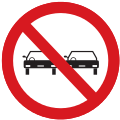 Argentina (no overtaking)
Argentina (no overtaking) Argentina (end of overtaking prohibition)
Argentina (end of overtaking prohibition) Australia
Australia.svg.png) Belarus (no overtaking and speed limit)
Belarus (no overtaking and speed limit) Canada (no overtaking)
Canada (no overtaking) Canada (overtaking permitted)
Canada (overtaking permitted) Chile (no overtaking)
Chile (no overtaking) Chile (end of overtaking prohibition)
Chile (end of overtaking prohibition) China
China Colombia
Colombia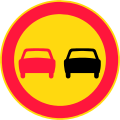 Finland (no overtaking)
Finland (no overtaking) Finland (no overtaking by trucks)
Finland (no overtaking by trucks) Finland (end of overtaking prohibition)
Finland (end of overtaking prohibition) Finland (end of trucks' overtaking prohibition)
Finland (end of trucks' overtaking prohibition) Greece (no overtaking)
Greece (no overtaking)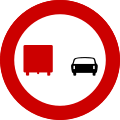 Greece (no overtaking by trucks)
Greece (no overtaking by trucks) Ireland
Ireland Japan
Japan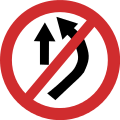 Nepal
Nepal Peru
Peru Puerto Rico
Puerto Rico Singapore
Singapore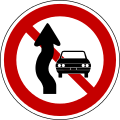 South Korea
South Korea Sweden (no overtaking)
Sweden (no overtaking) Sweden (no overtaking by trucks)
Sweden (no overtaking by trucks) Taiwan
Taiwan United Kingdom
United Kingdom United States
United States United States
United States Uruguay
Uruguay
Overtaking in racing

In racing, the rules allow overtaking from either side. Generally, the sides are classified as inside and outside overtaking, depending on the position of the overtaking car at the next curve since start of overtaking. The defending car usually blocks inside overtaking, because outside overtaking is riskier than inside overtaking.
See also
References
- ↑ Inside refers to the edge of the road closest to the kerb and outside closest to the centre.
- 1 2 Drive Safe Handbook page 75
- ↑ Never undertake a Heavy Goods Vehicle
- ↑ Article 21, Færsdelsloven, LBK No. 1386 of 12 November 2013 (in Danish)
- ↑ Article 24, Færsdelsloven, LBK No. 1386 of 12 November 2013 (in Danish)
- ↑ The Highway Code - Motorways
- ↑ The Highway Code - Overtaking
- ↑ The Highway Code - Introduction
- ↑ California Vehicle Code § 21754
- ↑ Code of Virginia § 46.2-841
- ↑ Utah Code § 41-6a-705
- ↑ New York State Law Title VII Article 25 Section 1123
- ↑ South Dakota Code § 32-26-27
- Ian Walker (August 2006). "Drivers over taking bicyclists" (PDF). Accident Analysis & Prevention. University of Bath. 39 (2): 417–425. doi:10.1016/j.aap.2006.08.010. PMID 17064655. — a paper funded by the EPSRC to investigate how drivers overtake bicyclists
- "138–145: Overtaking". The Highway Code. Department for Transport.
- The National Safety Council (NSC Ireland). "Tutorial: Overtaking: How to Overtake Safely". John Ryan — Driving School Ireland.
- Brown ID, Tickner AH, Simmonds DC (March 1970). "Effect of prolonged driving on overtaking criteria". Ergonomics. 13 (2): 239–242. doi:10.1080/00140137008931137. PMID 5432365.
- Wilson, T; Best, W (1982). "Driving strategies in overtaking". Accident Analysis & Prevention. 14 (3): 179–185. doi:10.1016/0001-4575(82)90026-4.
- Tay Wilson (1998-03-30). "Seniors' driving style and overtaking: Is there a "comfortable traffic hole"?". Contemporary Ergonomics 1998. Taylor & Francis. ISBN 0-7484-0811-8.
- Hauer, E. (1971). "Accidents, Overtaking, and Speed control". Accident Analysis & Prevention. 3: 1–13. doi:10.1016/0001-4575(71)90016-9.
- Summala H. & Naatanen, R. (1988). "The zero-risk theory and overtaking decisions". In T. Rothengatter & R. de Bruin. Road user behaviour: Theory and research. Assen Maastrich: Van Gorcum. pp. 82–92.
- Driving Standards Agency (2005-03-15). Driving. The Stationery Office. pp. 119–122. ISBN 0-11-552641-2.
- "M-way overtaking ban for lorries". BBC News. 2004-12-03. Retrieved 12 October 2006.
- "Lorry Operators Challenge M42 Overtaking Ban". Transport News Network. 2005-11-04. Retrieved 12 October 2006.
- Ewan Tytler (1999). "The Responsibility of Overtaking". autosport.com. Retrieved 12 October 2006.
- "US State Laws".
External links
| Look up overtaking in Wiktionary, the free dictionary. |
| Wikimedia Commons has media related to Overtaking. |
- Advanced Driving UK - Advanced and Safe Overtaking
- Bob Kenyon (1996-12-19). "Spanish no-overtaking road signs". — a gallery of "no overtaking" road signs used in Spain